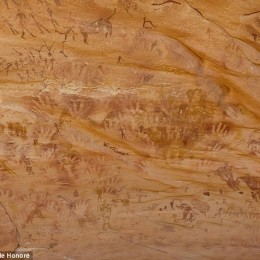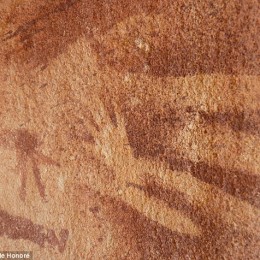Every day, archaeologists, and travelers alike come across new settlements and archaeological sites. In 2002, explorers stumbled across what is known as the Cave of Beasts in an empty desert near Egypt’s southwest border near Libya.
Their discovery could be considered either fantastic or eerie. What the amateur explorers found were 13 tiny handprints on the cave walls. However, after further investigation, archaeologists and researchers believe that they didn’t come from children. In fact, they believe that some of the handprints don’t even belong to humans.
The cave is also known as Wadi Sura II, and it includes nearly 5,000 images that were painted or engraved onto the stone walls nearly 8,000 years ago.

The small hand prints found are believed to have been stenciled, however, newer research suggests that the prints could have been formed by lizards. If one takes a look at one of the photos, they can see an adult hand print on one part of the cave with the small hand print on the inside. Comparing the two, it does appear that the hand is indeed much smaller than a child’s, as well as having slim, long fingers.
An anthropologist at the McDonald Institute of Archaeological Research, Emmanuelle Honore, said that she was absolutely stunned when she first saw the images. She had said that the prints were a lot smaller than baby hands and the fingers on the prints were too long to be human.
Honore had compared the print sizes to the newborn hand prints of children who were around 37 to 41 weeks old. She also included the sizes of newborn premature babies around 26 to 36 weeks old. After doing further research she began to feel that it was highly unlikely that the hands in the cave were human. She believes that they were created by the legs of desert monitor lizards or even baby crocodiles. If this is the case, then this is the first time that animals such as those had been discovered in the Sahara desert.
She said that the hand prints raise new perspectives in understanding the rocks in the area. She also said that it allows the researchers to study the behaviors and symbols of the universe and the populations in it. Perhaps with further research done in the area, she and her team of archaeologists and anthropologists can find out where the people got those animals and whether or not they are of significance. The question is if they were not just kept as pets, could they have had a religious symbolism? Why else would the animal prints appear on the wall?

The Eastern Sahara stretches into Libya, Sudan, and Chad and is considered the world’s largest warm, dry desert. Taking this into consideration, there weren’t many animals living in the area, nor are there many currently living there. In 8500 BC, the seasonal rainfall in the area was higher than it is now, and the rainy season attracted hunter-gatherers. By 5300 BC, the rains had stopped and the human settlements began receding into the highland areas. By 3500 BC, the settlements disappeared from the area completely. The rise of sedentary life along the Nile later become the pharaonic civilization that dominated the region for thousands of years.

Want The Vintage News delivered straight to your inbox? Subscribe to our weekly newsletter!
It is believed that the people had held the creatures up in order to make the hand prints on the walls. Many of those animal prints were found alongside human prints. Honore wouldn’t give any further information as to why that civilization would put animal prints next to theirs. She claimed that she couldn’t give a direct answer since it is hard for any kind of researcher to interpret those prints. Perhaps she is just as perplexed as the next person as to the significance of it all.
